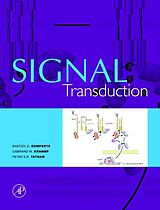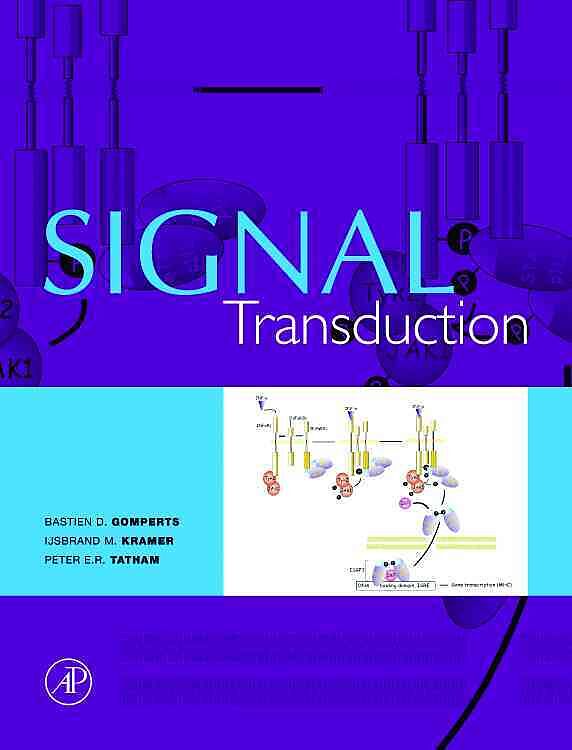Signal Transduction
Einband:
Kartonierter Einband
EAN:
9780122896323
Untertitel:
Englisch
Autor:
Bastien D. Gomperts, ljsbrand M. Kramer, Peter E.R. Tatham
Herausgeber:
Elsevier Science & Technology
Anzahl Seiten:
420
Erscheinungsdatum:
2003
ISBN:
978-0-12-289632-3
Informationen zum Autor Ijsbrand Kramer is a professor at the University of Bordeaux, working in the European Institute of Chemistry and Biology (IECB). He holds a Bachelors and Masters degree in BioMedicine from the University of Utrecht, The Netherlands, with a one year research-excursion in the Department of Cell Biology at the University of Liverpool, UK. He did his Ph.D. at the University of Amsterdam, in the Central Laboratory of Blood transfusion services (Stichting Sanquin) and worked as a post-doctoral fellow at the Hubrecht Laboratory in Utrecht and at the University of Washington in Seattle. He then took a lecturer position at the Department of Pharmacology at University College London, where he taught Signal Transduction (with Bastien Gomperts and Pether Tatham) and Pharmacology. Both teaching activities have been documented in textbooks: Signal Transduction (3 editions) and Receptor Pharmacology (CRC Press/Taylor Francis Group, 3 editions). Most of his research centers on the theme of inflammation, starting with neutrophils and the NADPH oxidase, synovial fibroblasts and destruction of the joint and more recently podosomes formation and extracellular matrix destruction in vascular endothelium. He moved to the University of Bordeaux for family reasons and switched from Pharmacology to Cell Biology, with a strong contribution to an introductory course for 1st year university students. Given the important teaching load and the general low level of student engagement in higher education he started to investigate the reasons for student failure (finding out about their expectations and attitudes) and the role of images and animations in comprehension. Scientific publications, web-based multimedia resources and dramatically enhanced retention rates (from 33 to 85%) are the fruits of these activities. At the same time he organized with University College London and Universitat Pompeu Fabra, Barcelona, summer schools on Receptor and Signalling Mechanism. He has been co-director of two European Programmes (Interbio and Transbio) that aimed at enhancing industrial innovation in the biomedical sector in the South West European Region (SUDOE). For book/publicity purposes, image of the author by Maarten Kramer Zusammenfassung Serves as a reference on cellular signalling processes. Starting with the basics! this book explains how cells respond to external cues (hormones! cytokines! neurotransmitters! adhesion molecules! extracellular matrix)! and shows how these inputs are integrated and co-ordinated. ...
Autorentext
Ijsbrand Kramer is a professor at the University of Bordeaux, working in the European Institute of Chemistry and Biology (IECB). He holds a Bachelors and Masters degree in BioMedicine from the University of Utrecht, The Netherlands, with a one year research-excursion in the Department of Cell Biology at the University of Liverpool, UK. He did his Ph.D. at the University of Amsterdam, in the Central Laboratory of Blood transfusion services (Stichting Sanquin) and worked as a post-doctoral fellow at the Hubrecht Laboratory in Utrecht and at the University of Washington in Seattle. He then took a lecturer position at the Department of Pharmacology at University College London, where he taught Signal Transduction (with Bastien Gomperts and Pether Tatham) and Pharmacology. Both teaching activities have been documented in textbooks: Signal Transduction (3 editions) and Receptor Pharmacology (CRC Press/Taylor Francis Group, 3 editions). Most of his research centers on the theme of inflammation, starting with neutrophils and the NADPH oxidase, synovial fibroblasts and destruction of the joint and more recently podosomes formation and extracellular matrix destruction in vascular endothelium. He moved to the University of Bordeaux for family reasons and switched from Pharmacology to Cell Biology, with a strong contribution to an introductory course for 1st year university students. Given the important teaching load and the general low level of student engagement in higher education he started to investigate the reasons for student failure (finding out about their expectations and attitudes) and the role of images and animations in comprehension. Scientific publications, web-based multimedia resources and dramatically enhanced retention rates (from 33 to 85%) are the fruits of these activities. At the same time he organized with University College London and Universitat Pompeu Fabra, Barcelona, summer schools on Receptor and Signalling Mechanism. He has been co-director of two European Programmes (Interbio and Transbio) that aimed at enhancing industrial innovation in the biomedical sector in the South West European Region (SUDOE).For book/publicity purposes, image of the author by Maarten Kramer
Klappentext
Signal Transduction now in paperback, is a text reference on cellular signalling processes. Starting with the basics, it explains how cells respond to external cues (hormones, cytokines, neurotransmitters, adhesion molecules, extracellular matrix, etc), and shows how these inputs are integrated and co-ordinated. The first half of the book provides the conceptual framework, explaining the formation and action of second messengers, particulary cyclic nucleotides and calcium, and the mediation of signal pathways by GTP-binding proteins. The remaining chapters deal with the formation of complex signalling cascades employed by cytokines and adhesion molecules, starting at the membrane and ending in the nucleus, there to regulate gene transcription. In this context, growth is an important potential outcome and this has relevance to the cellular transformations that underlie cancer. The book ends with a description at the molecular level of how signalling proteins interact with their environment and with each other through their structural domains. Each main topic is introduced with a historical essay, detailing the sources key observations and experiments that set the scence for recent and current work.
* Coherent, precise text providing insight in depth to a subject that is central to cell biology and fundamental to many areas of biomedicine
* Conceptual colour artwork assists with the comprehension of key topics
* Extensive referencing provides an invaluable link to the core and historical literature
* Margin notes highlighting milestones in the evolution of our understanding of signalling mechanisms
Zusammenfassung
Serves as a reference on cellular signalling processes. Starting with the basics, this book explains how cells respond to external cues (hormones, cytokines, neurotransmitters, adhesion molecules, extracellular matrix), and shows how these inputs are integrated and co-ordinated.
Inhalt
Prologue: Signal transduction, Origins and Personalities First Messengers Receptors GTP-Binding Proteins and Signal Transduction Effector Enzymes Coupled to GTP-binding Proteins: Adenylyl Cyclase and Phospholipase The Regulation of Visual Transduction Calcium and Signal Transduction Calcium Signalling Phosphorylation and Dephosphorylation: Protein Kinases A and C Growth Factors: Setting the Framework Signalling Pathways Operated by Receptor Protein Tyrosine Kinases Signalling Pathways Operated by Mon-receptor Protein Tyrosine Kinases Phosphoinositide 3-kinases Signal Transduction to and from Adhesion Molecules Adhesion Molecules and Trafficking of Leukocytes Signalling through Receptor Bound Protein Serine-threonine Kinases Protein Dephosphorylation and Protein Phosphorylation Protein Domains and Signal Transduction

Leider konnten wir für diesen Artikel keine Preise ermitteln ...
billigbuch.ch sucht jetzt für Sie die besten Angebote ...
Die aktuellen Verkaufspreise von 6 Onlineshops werden in Realtime abgefragt.
Sie können das gewünschte Produkt anschliessend direkt beim Anbieter Ihrer Wahl bestellen.
Loading...
Die aktuellen Verkaufspreise von 6 Onlineshops werden in Realtime abgefragt.
Sie können das gewünschte Produkt anschliessend direkt beim Anbieter Ihrer Wahl bestellen.
| # | Onlineshop | Preis CHF | Versand CHF | Total CHF | ||
|---|---|---|---|---|---|---|
| 1 | Seller | 0.00 | 0.00 | 0.00 |
